
Definition: Aging in Place is the idea that an elderly person will be able to live in the residence of his or her choice for as long as possible. To age in place a person must be able to:
For most elderly people, the residences of choice are their own homes. If a person wishes to continue to live independently at home, he or she must plan ahead for the changes that may be needed to allow that person to continue to live at home.
The following chart reviews some of the physical and cognitive changes that may occur as people age and the adaptations that can be provided to allow people to continue to live at home:
| Physical Change | Adaptations | Photo/Video |
| Decreased mobility, including the possible need to use a cane, walker or wheelchair. | -Widen doorways to accommodate a walker or wheelchair. -Add a ramp to one entryway of the home. -Raise sunken living room or sunken den floors to make the floor of the home one level. -Install chair lifts for second story or basement stairs. -Remove throw rugs. -Remove unnecessary furniture and clutter. -Provide chairs with firm support and/or place chairs on risers. -Install a raised toilet seat or a tall toilet. -Install a hand held shower and provide a shower stool or bath bench. -Install grab bars in the bathroom, near the bed, and near the entry ways. |
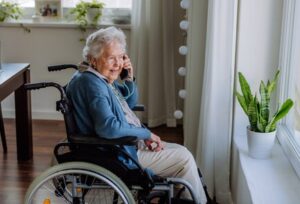
|
| Reduced vision, including visual impairments due to cataracts, glaucoma, macular degeneration, or diabetic retinopathy. | -Increase lighting by installing brighter LED light bulbs, additional light fixtures, or additional lamps. -Increase contrast on floors, walkways and steps. -contrast dark rugs or mats on light floors, light rugs or mats on dark floors. -place contrasting tape on the edges of steps. -Keep needed items in the same places for easy access. -frequently used kitchen items between chest and head height. -keep items where they are used. -Provide large button electronic and communication devices. -large button telephone -large button television remote -Use magnifiers -Adjust settings on computers to enlarge print and increase contrast. -Mark stove dials, water faucet handles with raised dots to mark temperatures. |
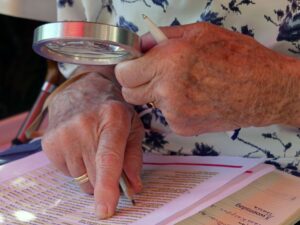
|
| Hearing loss | -Increase the volume on telephone settings, doorbell, smoke and carbon monoxide alarms. -Replace old smoke and carbon monoxide alarms with alarms that include flashing lights. -Use telephones and alarm clocks that include flashing lights. -Provide an alarm clock that includes a bed shaker. -Sign up for telephone TTY service if hearing impairment is severe. |
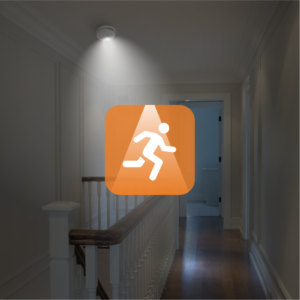 |
| Decreased neck and upper body range of motion. | -Rearrange kitchen and bathroom cupboard so that frequently used items are placed between waist and head height. -Provide a reacher for higher or lower shelves. -Use long handled bathing and grooming tools – long handled sponge, long handled comb. -Place grab rails on the bed to assist with bed mobility. -Use long handled tools for gardening and yard work. |
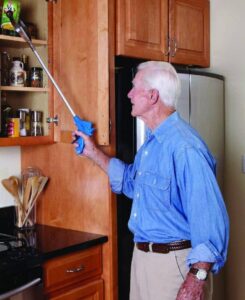 |
| Decreased strength and endurance | -Slide heavy objects along countertops, tables, or the floor rather than lifting. -Use a wheeled cart to transport heavy objects. -Place chairs or benches in strategic places around the house or yard to provide frequent rest spots. -Provide an electric or large handled manual jar opener. -Replace round door knobs with lever style door handles. -Request that prescription medications be placed in prescription bottles with regular caps rather than child proof caps. |
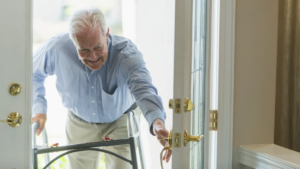 |
| Decreased reaction time and declining cognitive skills | -Provide a white board or large calendar to write down important dates and appointments. -Use a white board or pad of paper to write a daily to do list. -Place medications in a weekly pill organizer. -Set alarm reminders for medication and meal times. -Provide prepackaged meals that can be easily heated in a microwave. -Set the hot water heater temperature to 120 degrees or lower to prevent accidental burns. -Label cupboards, closets, and drawers with the contents. -Organize clothing into outfits that may be easily obtained and put on. -Place written safety reminders near the stove, coffee maker, and any other devices that might be accidentally left on. |
 |
Services for Aging in Place
This list includes services that many elderly people use to help them continue to live in their own homes safely:
MEALS ON WHEELS – available through local community centers or aging and disability centers, Meals on Wheels volunteers deliver nutritious meals to people who are homebound or near homebound for a small fee.
CLEANING PERSON/SERVICE – many elderly people hire a cleaning person to complete heavy cleaning tasks.
HOME HEALTH / INDEPENDENT LIVING AIDE– These services are available to assist elderly people with bathing, dressing, meal preparation, light cleaning, and shopping. Home health aides for self-care assistance may be partially paid for by third party payors if the home health aide is provided as a part of home health nursing services.
Home health aides make a remarkable difference in the lives of the sick, disabled and elderly. By assisting with personal tasks, they allow those who would otherwise need a higher level of care the opportunity to live on their own.
PERSONAL ALARM – a personal alarm system, such as Life Line, allows elderly people to press a single button to call for help in an emergency. The button automatically dials a call center that checks on the person and calls for police or paramedics if needed.
HOME HEALTH CARE / VISITING NURSE – Home health care services are available to people who are completely homebound. A wide range of medical, nursing, rehabilitation, hospice, and social services can be delivered to patients in their place of residence (e.g. private residence, senior living center, assisted living facility). People who have recently been hospitalized or have undergone rehabilitation in a skilled nursing facility may receive home health services to allow return to home with continued care. Home health care services include care provided by home health aides and skilled nurses, respiratory therapists, dieticians, physicians, chaplains, and volunteers; provision of durable medical equipment; home infusion therapy; and physical, speech, and occupational therapy.
– OT in home care is covered if the person is home bound and requires intermittent skilled nursing care, PT, or ST before OT commences. OT services can continue after the need for skilled nursing, PT, or ST has ended.
ADULT DAY CARE – Adult day care is a planned program of activities designed to promote well being though social and health related services. Adult day care centers operate during daytime hours, Monday through Friday, in a safe, supportive, cheerful environment. Nutritious meals that accommodate special diets are typically included, along with an afternoon snack. Adult day care centers can be public or private, nonprofit or for-profit. The intent of an adult day center to provide older adults an opportunity to get out of the house and receive both mental and social stimulation as well as to give caregivers a much needed break in which to attend to personal needs, or simply rest and relax
SENIOR CENTERS – community based senior centers provide meals and activities for elderly people who are living in the community.
HOSPICE AND PALLIATIVE CARE – Although death is a natural part of life, the thought of dying understandably still frightens many people. However, hospice care represents a compassionate approach to end of life care, enhancing the quality of remaining life and enabling the patient to live as fully and as comfortably as possible. Hospice is traditionally an option for people whose life expectancy is six months or less and involves palliative care (pain and symptom relief) rather than ongoing curative measures, enabling patients to live their last days to the fullest, with purpose, dignity, grace, and support. While some hospitals, nursing homes, and other health care facilities provide hospice care onsite, in most cases hospice is provided in the patient’s own home. This enables them to spend their final days in a familiar, comfortable environment, surrounded by loved ones who can focus more fully on the patient with the support of hospice staff.
– OT in hospice care is provided to persons who are certified as terminally ill (medical prognosis of < 6 months to live)
Alternative Living Arrangements
If an elderly person can no longer remain in his or her own home, there are several alternatives that people may choose. Elderly people often collaborate with their families to come up with the best living arrangement, based on health, mobility, and family dynamics. The following list provides descriptions of some of the alternative living arrangements available to elderly people:
LIVING WITH FAMILY
Many families care for elderly people in a family home, rather than expecting the elderly person to live independently. Families provide varying levels of care depending on the skills the family members possess.
SENIOR APARTMENTS OR RETIREMENT CENTERS
Apartment complexes that specialize in renting to senior citizens. The apartments are usually smaller in size and adapted for mobility problems. People who rent senior apartments must be able to live independently. Retirement centers may also include a senior center that provides meals and activities, on-site medical facilities, and an on-site pharmacy.
ASSISTED LIVING
Assisted living is a residential option for seniors who want or need help with some of their ADLs – for example, help with cooking meals, getting to the bathroom in the middle of the night, keeping house, and traveling to appointments. Assisted living facilities offer the safety and security of 24-hour support and access to care. Day or night, help is only a phone call away. If a person is having more and more difficulty with everyday activities such as showering, dressing, getting around the house, and running errands, an assisted living facility may be the answer. They can get daily support, while remaining as independent as possible.
An assisted living facility may be a good choice for patients if they need more personal care services than they can get at home or from an independent living retirement community, but they don’t need the round-the-clock medical care and supervision of a skilled nursing home. A good facility will develop a personalized plan that meets their needs and accommodates their disabilities, while giving the patient the freedom to do what they can for themselves. Most facilities have a group dining area and common areas for social and recreational activities.
SKILLED NURSING FACILITY (SNF)
A skilled nursing home is normally the highest level of care for older adults outside of a hospital. Skilled nursing facilities provide 24-hour nursing care, medications, rehabilitation services including physical, occupational, speech, and respiratory therapies, meals, and personal care aides. A licensed physician supervises each patient’s care. People who have acute health conditions often stay in skilled nursing facilities on a short-term basis to receive continued nursing care or rehabilitation prior to returning to home. Medicare will pay for up to 100 days in a skilled nursing facility if a person has an acute health condition that had required a 3-day hospital stay.
– OT in SNF is covered if the patient requires skilled nursing or skilled rehabilitation (e.g. OT) on a daily basis (i.e. minimum 5 days/week).
– OT is covered as an outpatient service when provided by or under arrangements with any Medicare certified provider (i.e. SNF) or when provided as part of comprehensive rehabilitation facility services.
LONG TERM CARE FACILITY (LTCFS)
Long term care facilities are designed for people who require 24-hour personal care but no longer require skilled nursing care. Medications, meals, and personal care aides are provided. Rehabilitation services are usually available through an on-site outpatient clinic. Long term care facilities are the types of facilities often referred to as “nursing homes”. Some long-term care facilities specialize in care for people with Alzheimer’s disease, intellectual disabilities, or mental health conditions.
TRANSITIONAL CARE FACILITIES
A setting that cares for older adults with complex needs as they transition from an acute care setting to their home or other care setting and prepares patients and family caregivers to more effectively manage changes in health associated with multiple chronic illness. After leaving a particular care setting, older patients may not understand how to manage their health care conditions or whom to call if they have a question or if their condition gets worse. Poorly managed transitions can lead to physical and emotional stress for both patients and their caregivers.